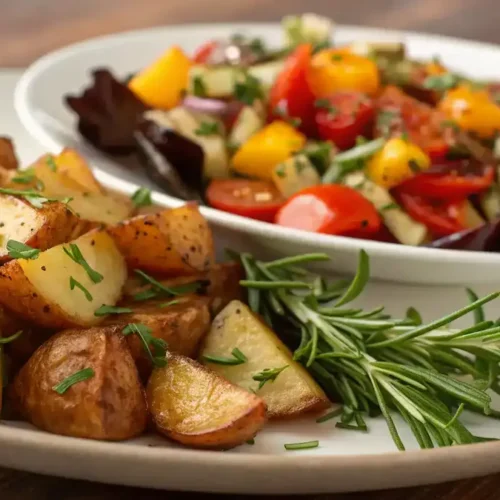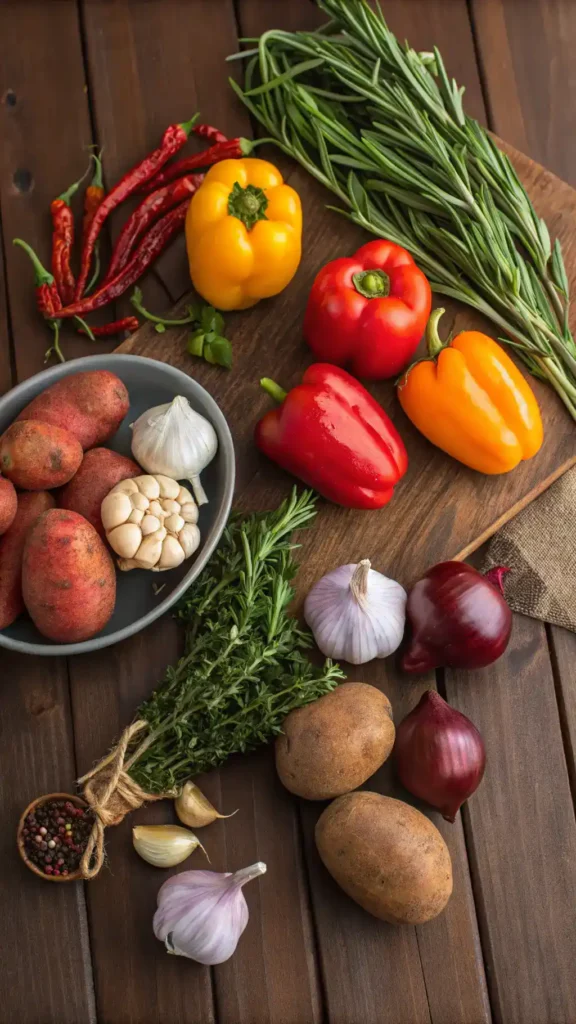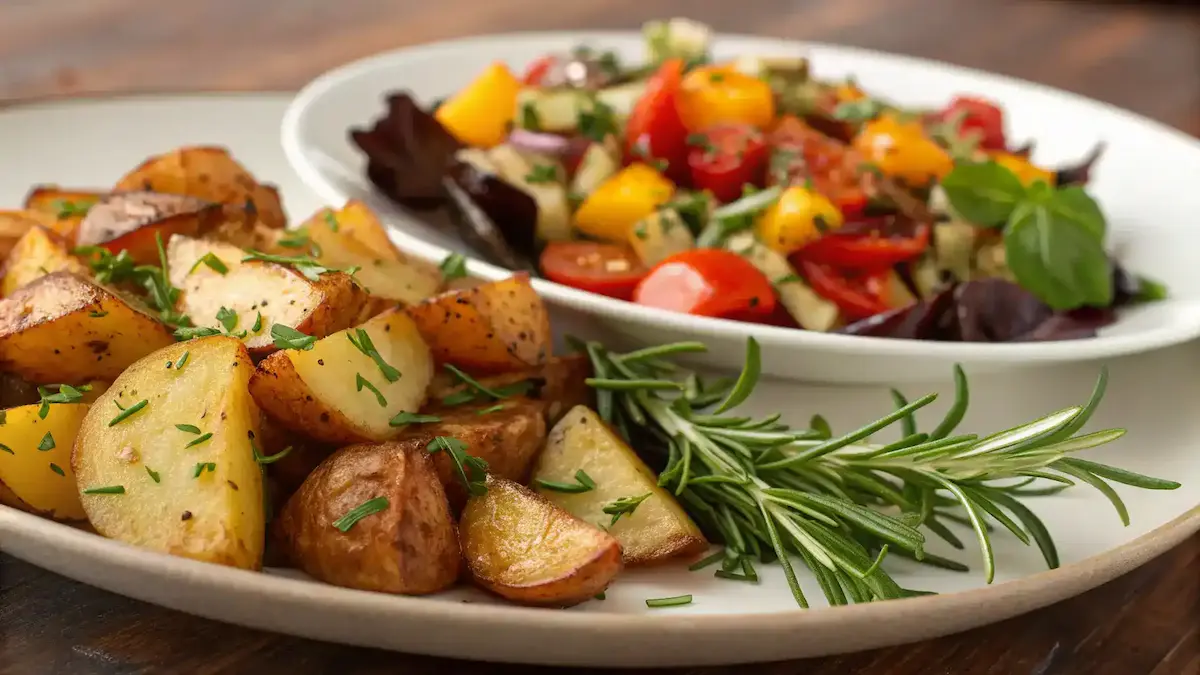Are you looking for a way to enjoy the comforting taste of potatoes while keeping your meals healthy? If so, you’re in the right place! Low-Calorie Potato Recipes offer a delicious solution that allows you to savor this versatile vegetable without compromising your health goals. Not only do these recipes promote weight management, but they also provide essential nutrients, including fiber and vitamins. Consequently, they enhance satiety and support heart health. So, let’s dive into the world of low-calorie cooking and explore how you can create satisfying dishes that are both nutritious and flavorful!

Low-Calorie Potato Recipes
Equipment
- 1 Pot For boiling potatoes.
- 1 Baking sheet For baking potatoes.
- 1 Steamer For steaming potatoes.
- 1 Knife For cutting potatoes.
- 1 Cutting board For chopping ingredients.
Ingredients
Potatoes
- 4 medium Fresh potatoes (Yukon Gold, red, or sweet) Choose firm potatoes without blemishes.
- 2 tablespoons Olive oil Use sparingly for healthy fats.
Herbs
- 1 tablespoon Fresh herbs (rosemary, thyme, or parsley) Enhances flavor.
- 1 teaspoon Garlic (fresh or powdered) For flavor boost.
- 1 medium Onion Adds sweetness and depth.
Spices
- 1 teaspoon Paprika For seasoning.
- 1 teaspoon Black pepper For seasoning.
- 1 cup Vegetable broth For added flavor.
- 1/2 cup Non-dairy milk (almond or oat) For creaminess.
- 2 tablespoons Nutritional yeast For a cheesy flavor without the calories.
Instructions
Preparation
- Select Fresh Potatoes: Start with fresh potatoes, as they are the star ingredient. Choose varieties like Yukon Gold or red potatoes for their creamy texture and flavor.
- Wash and Peel: Rinse your potatoes under cold water. If you prefer, peel them for a smoother texture, but leaving the skin on adds extra dietary fiber.
- Cut into Uniform Pieces: Chop the potatoes into even-sized pieces. This ensures they cook evenly, preventing some from being undercooked while others are overdone.
Cooking
- Choose Your Cooking Method: Decide whether to boil, bake, or steam your potatoes. For boiling, place them in a pot of salted water. For baking, preheat your oven to 400°F (200°C) and place them on a baking sheet. Steaming is another great option, as it helps retain nutrients.
- Cook Until Tender: Boil or steam the potatoes for about 15-20 minutes, or until fork-tender. If baking, cook for about 30-40 minutes, turning halfway through for even browning.
- Season to Taste: Once cooked, season your potatoes with herbs and spices. Garlic powder, onion powder, and fresh herbs like rosemary or thyme work wonderfully. For a creamy texture, add a splash of non-dairy milk or a sprinkle of nutritional yeast.
- Serve and Enjoy: Finally, serve your low-calorie potato dish warm. Pair it with grilled vegetables or a fresh salad for a complete meal.
Notes
| Calories | Fat | Protein | Carbs |
|---|---|---|---|
| 150 | 3g | 4g | 30g |
Table of Contents
Key Benefits
Low-calorie potato recipes offer a delightful way to enjoy this versatile vegetable while staying aligned with your health goals. They are not only delicious but also packed with essential nutrients. Here are some key benefits:
- Weight Management: These recipes help you enjoy potatoes without the guilt, making them perfect for a low-calorie diet.
- Nutrient-Rich: Potatoes are a great source of vitamins and minerals, including vitamin C and potassium, which support overall health.
- High Fiber Content: The fiber in potatoes enhances satiety, keeping you full longer and reducing the urge to snack.
- Heart Health: Low-calorie potato recipes can contribute to heart health, especially when prepared with healthy cooking methods.
- Versatile Cooking: You can easily adapt these recipes to fit various dietary preferences, making them suitable for everyone.
By incorporating low-calorie potato recipes into your meals, you can enjoy flavorful dishes that support healthy eating habits.
Ingredients
To create delicious low-calorie potato recipes, it’s essential to focus on fresh, whole ingredients. Here’s what you’ll need:
- Fresh Potatoes (choose from russet, sweet, or red varieties)
- Garlic (2-3 cloves, minced for flavor)
- Onion (1 medium, diced for sweetness)
- Bell Peppers (1-2, chopped for color and crunch)
- Vegetable Broth (1 cup, for moisture and depth)
- Olive Oil (1-2 tablespoons, for roasting)
- Low-Fat Dairy (like Greek yogurt or low-fat cheese, for creaminess)
- Herbs and Spices (such as rosemary, thyme, paprika, or black pepper, to enhance flavor)

When selecting your potatoes, consider their nutritional benefits. Sweet potatoes, for instance, are rich in vitamins and fiber, making them a fantastic choice for a low-calorie diet. Additionally, russet potatoes are versatile and can be used in various cooking methods. If you’re looking to cut calories further, you might replace olive oil with a light spray of cooking oil or use vegetable broth to sauté your vegetables instead.
Moreover, don’t hesitate to experiment with herbs and spices. They can elevate your dish without adding extra calories. For example, a sprinkle of paprika can add a delightful smokiness, while fresh herbs like parsley or cilantro can brighten up your meal. Remember, the key to low-calorie potato recipes is to maximize flavor while keeping the calorie count in check!
How to Make Low-Calorie Potato Recipes
Making low-calorie potato recipes is both fun and rewarding. Follow these simple steps to create delicious dishes that are healthy and satisfying.
- Select Your Potatoes: Start by choosing fresh potatoes. Varieties like russet or sweet potatoes are great options. They are nutrient-rich and perfect for a low-calorie diet.
- Wash and Prep: Rinse your potatoes under cold water. Scrub them gently to remove any dirt. Then, peel them if desired, although leaving the skin on adds fiber content.
- Cut Them Right: Dice or slice your potatoes into even pieces. This ensures they cook uniformly. For example, smaller cubes will cook faster, which is ideal for roasting.
- Choose Your Cooking Method: Decide how you want to cook your potatoes. Steaming, baking, or roasting are all healthy alternatives. For instance, roasting with a drizzle of olive oil and herbs enhances flavor without adding excessive calories.
- Season Wisely: Use herbs and spices to elevate your dish. Garlic powder, paprika, or rosemary can add depth. Additionally, consider low-calorie seasoning alternatives to keep it healthy.
- Monitor Cooking Time: Keep an eye on your potatoes as they cook. Overcooking can lead to mushiness. For crispy roasted potatoes, aim for a golden-brown color.
- Serve and Enjoy: Once cooked, serve your low-calorie potato recipes hot. Pair them with grilled chicken or a fresh salad for a complete meal. Garnish with fresh herbs for an appealing presentation.

By following these steps, you’ll create low-calorie potato recipes that are not only delicious but also support your weight management goals. Remember, the key is to enjoy the process and experiment with flavors!
Pro Tips, Variations, and Common Problems
When it comes to crafting delicious low-calorie potato recipes, a few insider tips can make all the difference. Here are some pro tips to elevate your dishes, along with variations and solutions to common cooking challenges.
Pro Tips
– Choose the Right Potatoes: Opt for fresh potatoes like russets or sweet potatoes. They are nutrient-rich and provide a satisfying base for your low-calorie potato recipes.
– Experiment with Cooking Methods: Steaming, baking, or roasting are excellent methods to keep your potatoes low in calories. For instance, roasting diced potatoes with a touch of olive oil and herbs enhances flavor without adding excessive calories.
– Season Smartly: Use herbs and spices to boost flavor without extra calories. Garlic powder, paprika, and fresh herbs like rosemary or thyme can transform your dish.
Creative Variations
– Add Non-Starchy Vegetables: Incorporate bell peppers, zucchini, or spinach into your low-calorie potato recipes. This not only enhances flavor but also increases fiber content, promoting satiety.
– Swap for Low-Fat Dairy: For a creamy texture, consider using Greek yogurt instead of sour cream. This substitution keeps your dish light while adding protein.
– Try Different Seasoning Alternatives: If you’re looking for a kick, add a splash of lemon juice or a sprinkle of nutritional yeast for a cheesy flavor without the calories.
Common Problems and Solutions
– Mushy Potatoes: If your potatoes turn out mushy, it may be due to overcooking. To avoid this, keep an eye on cooking times and test for doneness with a fork. They should be tender but not falling apart.
– Lack of Flavor: If your dish tastes bland, consider adjusting your seasoning. Adding salt gradually can enhance flavors. Additionally, a splash of vegetable broth can add depth without extra calories.
– Uneven Cooking: To ensure even cooking, cut your potatoes into uniform sizes. This way, they will cook at the same rate, preventing some pieces from being undercooked while others are overdone.
By keeping these tips in mind, you’ll be well on your way to mastering low-calorie potato recipes that are both delicious and satisfying. Enjoy your culinary journey!
Serving Suggestions
When it comes to enjoying your low-calorie potato recipes, presentation is key. Not only do beautifully plated dishes tantalize the taste buds, but they also elevate the dining experience. Here are some delightful serving suggestions that will impress your guests while keeping your meals healthy and appealing:
- Plating Ideas: Start by using a colorful plate to contrast with the earthy tones of the potatoes. For instance, a vibrant green salad can add a refreshing touch. Arrange your potatoes in a neat stack or a fan shape to create visual interest.
- Garnishing: Fresh herbs like parsley, chives, or cilantro can brighten up your dish. A sprinkle of low-fat cheese or a dollop of Greek yogurt can also enhance flavor without adding too many calories.
- Casual Settings: For a relaxed family dinner, serve your low-calorie potato recipes in a large bowl at the center of the table. This encourages sharing and creates a warm atmosphere. Pair them with grilled chicken or fish for a balanced meal.
- Elegant Presentations: If you’re hosting a dinner party, consider individual servings. Use small ramekins for baked potato dishes or elegant plates for roasted potatoes. Add a drizzle of balsamic reduction or a light vinaigrette for a gourmet touch.
- Side Dish Pairings: Complement your potatoes with non-starchy vegetables like steamed broccoli or a mixed greens salad. These options not only add color but also boost the fiber content of your meal, supporting your weight management goals.
- Creative Serving Options: For a fun twist, serve mashed potatoes in lettuce wraps or as a filling for bell peppers. This not only looks appealing but also keeps the meal light and nutritious.
Ultimately, the way you serve your low-calorie potato recipes can make a significant difference in how they are perceived. So, whether you opt for a casual family-style setting or an elegant plated presentation, remember that a little creativity goes a long way in making healthy eating enjoyable!
Preserving and Reheating
To preserve your low-calorie potato recipes, store them in airtight containers in the refrigerator. This method keeps them fresh for up to three days. If you want to extend their shelf life, consider freezing them. In the freezer, they can last for about three months. However, make sure to use vacuum-sealing or freezer-safe bags to prevent freezer burn. Additionally, always label your containers with the date to keep track of freshness. Food safety is crucial, so remember to cool your dishes to room temperature before storing them. This practice helps prevent bacterial growth and spoilage.
Reheating Methods
When it comes to reheating low-calorie potato recipes, you have several options. For the best results, consider using the oven or stovetop. Firstly, preheat your oven to 350°F (175°C). Then, place your potatoes in an oven-safe dish, adding a splash of vegetable broth or a drizzle of olive oil to keep them moist. Cover the dish with foil to trap steam, and reheat for about 15-20 minutes. Alternatively, if you’re short on time, the microwave is a quick option. Just place your potatoes in a microwave-safe bowl, add a tablespoon of water, and cover with a damp paper towel. Heat in 30-second intervals, stirring in between, until warmed through.
For those who love a crispy texture, the air fryer is a fantastic choice. Set it to 350°F (175°C) and reheat your potatoes for about 5-10 minutes. This method revives their crunchiness while keeping them deliciously flavorful. Regardless of the method you choose, always check for doneness before serving. By following these simple reheating techniques, you can enjoy your low-calorie potato recipes just as much as when they were freshly made!
Conclusion
In summary, making Low-Calorie Potato Recipes is a delightful journey that showcases the versatility of this beloved vegetable. By focusing on fresh ingredients, such as russet or sweet potatoes, and utilizing healthy cooking methods like steaming or roasting, you can create dishes that are both nutritious and satisfying. Moreover, the simplicity of these recipes makes them accessible for everyone, whether you are a seasoned chef or a beginner in the kitchen. So, I encourage you to roll up your sleeves and give it a try! You might just discover a new favorite dish.
Share Your Experience
Additionally, I would love to hear about your culinary adventures! Feel free to share your results or ask any questions you may have. Cooking is all about experimentation, so don’t hesitate to try different herbs, spices, or even pairings to make these Low-Calorie Potato Recipes uniquely yours. Remember, the kitchen is a place for creativity and fun, and these recipes are a fantastic way to explore that. Enjoy the process, and happy cooking!
FAQs
Here are some common questions about Low-Calorie Potato Recipes that can help you make the most of this versatile ingredient.
1. What are the best potatoes for low-calorie recipes?
When it comes to Low-Calorie Potato Recipes, opt for varieties like sweet potatoes or russets. These types are nutrient-rich and provide a good amount of dietary fiber, which enhances satiety. Additionally, they can be prepared in various ways to keep your meals exciting.
2. How can I enhance the flavor of low-calorie potato dishes?
To boost flavor without adding calories, use fresh herbs and spices. For example, rosemary, garlic, or paprika can elevate your dishes significantly. Moreover, consider using low-fat dairy options, like Greek yogurt, for creaminess without the extra calories.
3. What cooking methods are best for low-calorie potatoes?
Steaming, baking, or roasting are excellent methods for preparing low-calorie potatoes. These techniques preserve nutrients while keeping the calorie count low. For instance, roasting diced potatoes with a drizzle of olive oil and herbs can create a deliciously crispy texture.
4. How can I store and reheat leftover low-calorie potato dishes?
To store your low-calorie potato dishes, place them in airtight containers in the refrigerator. They typically last for up to three days. When reheating, the microwave is quick, but using the oven can help maintain a crispy texture, which is often preferred.
5. Can I make low-calorie potato recipes in advance?
Absolutely! Preparing low-calorie potato recipes in advance is a great way to save time. Just ensure you store them properly in airtight containers. Additionally, you can reheat them as needed, making meal prep both convenient and healthy.

